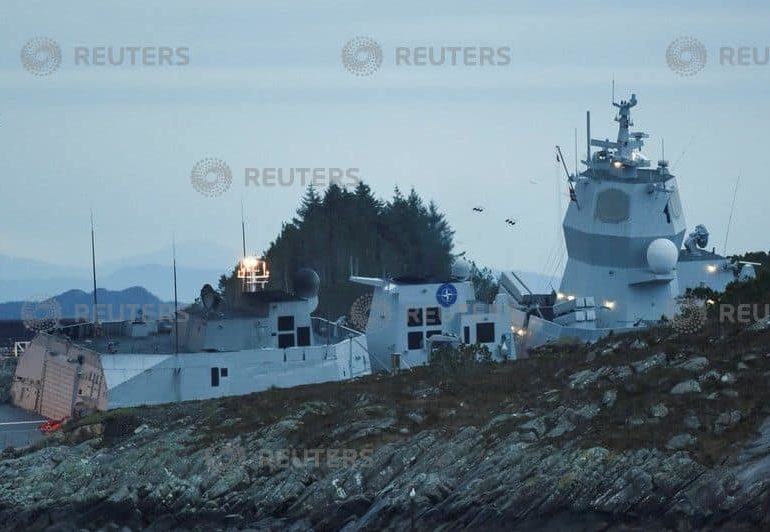An oil tanker and a Norwegian navy frigate collided off Norway‘s west coast on Thursday, injuring eight people and triggering the shutdown of a North Sea crude export terminal, Norway‘s largest gas processing plant and several offshore fields.
The frigate, which recently took part in a major Nato military exercise, was tilting on one side and slowly sinking, live television pictures showed. The Norwegian military said it was attempting to save the ship.
“The military is leading a salvage operation in cooperation with the Coast Guards,” Norway‘s armed forces said in a statement.
The Kollsnes gas plant, with a processing capacity of 144.5 million cubic metres per day, has also been shut, Equinor said. It was not immediately clear when it would restart operations.
The plant processes gas from the Troll, Kvitebjoern and Visund fields and sends it to Britain and the rest of Europe. Gas output from the Troll A platform had been shut, said an Equinor spokeswoman.
UK wholesale gas prices were up ahead of the incident and increased further afterwards. Gas for immediate delivery was up 6.2 per cent at 66.50 pence per therm at 1136 GMT. Norway is a major supplier of gas to Britain so big outages can impact UK gas prices.
Flows from Norway to Britain were down by 14-15 million cubic metres due to the outage at Kollsnes.
“Norwegian outages due to the collision have prompted extra buying. The market was already quite bullish due to lower temperatures. It is also not clear how long they (the outages) will last,” a British gas trader said.
There was no sign of any leak from the Sola TS oil tanker, although it would return to port for inspection, rescue leader Ben Vikoeren at the Joint Rescue Coordination Centre for southern Norway told Reuters.
The tanker had left Equinor’s Sture oil shipment terminal with a cargo of crude, and the facility would be temporarily shut as a precautionary measure, the company said.
The Sture terminal receives oil via pipelines from a string of North Sea fields, including the Oseberg, Grane, Svalin, Edvard Grieg and Ivar Aasen, which in turn is exported to global markets on oil tankers.
The Sture terminal has a capacity to store one million cubic metres of crude oil and 60,000 cubic metres of liquefied petroleum gas in rock chambers.
LPG mix and naphtha are also exported from the terminal via the Vestprosess pipeline to the Mongstad oil terminal.
It was not clear for how long the Sture terminal would remain closed, said Equinor, adding that oil output from Oseberg and Grane, which the firm operates, was shut as a result.
Oseberg is one of the crude streams underpinning the global Brent oil benchmark. Brent crude futures were up 71 cents to $72.78 a barrel by 1007 GMT.
Output at Ivar Aasen, which produced about 95,000 barrels of oil equivalents per day in the third quarter, has also been shut down, operator Aker BP told Reuters.
Production at the Edvard Grieg field was also shut down, a source with knowledge of its operations said.
The KNM Helge Ingstad frigate’s crew of 137 had been evacuated, Vikoeren said. Eight people suffered light injuries.
The Sola TS, an Aframax class vessel built in 2017, belongs to Tsakos Energy Navigation, according to the company’s website.
The KNM Helge Ingstad had recently taken part in Nato’s Trident Juncture military exercise, which centred on the defence of Norway.



